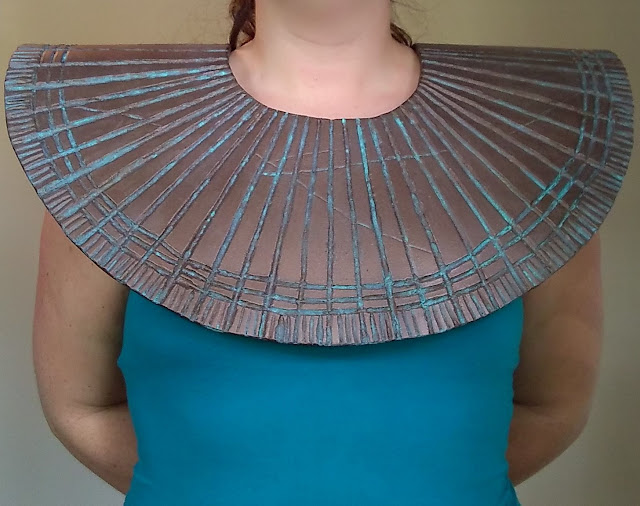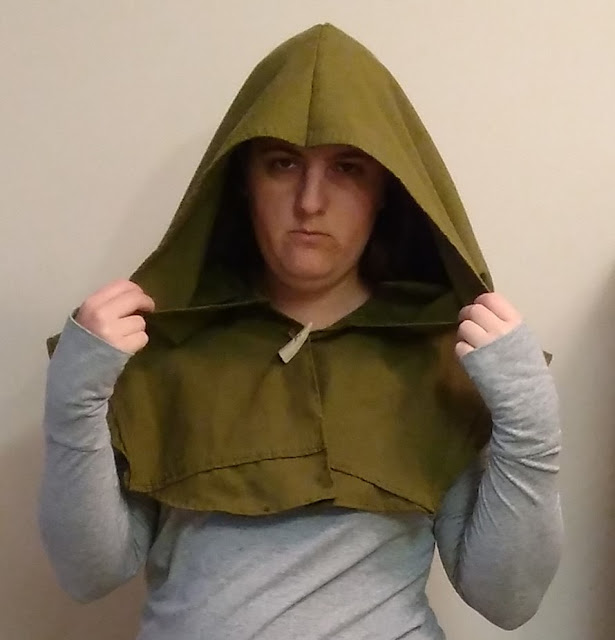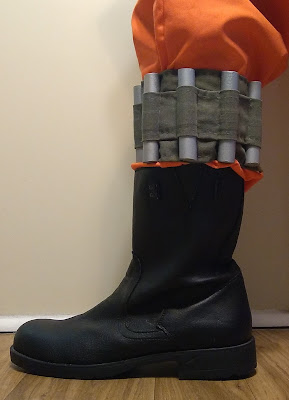How to make the collar from the Stargate Anubis Guard
For those intent on becoming the Prime of Ra and adopting the appearance of ancient Egyptian gods to terrorize the populace, welcome to my step-by-step guide of becoming the Anubis guard in the Stargate film. Most of these elements are going to be made from EVA foam, so this simple collar-piece was a good introduction to cutting, detailing, shaping, and painting foam.
References
Materials
-8mm EVA foam
-E600 clear glue
-Dark copper metallic spray paint
-Plastidip
-Turquoise acrylic paint
Tools
-Dremel tool with sanding attachment
-Box cutter
-Woodburner
-Foam wedge for painting, paper towels
1. Gather the materials
For this build, you're going to need a thinner EVA foam most easily purchased these days from craft stores. I chose a 8mm thickness, picking up a roll from a craft store for about $20. For this project, I needed about a third of the 24in x 60in roll. For the paints, I chose a dark copper metallic spray paint from Rustoleum. For the Horus guards the metal appears more bronze or gold, but the Anubis guard appear to be a worn copper. You can find the spray paint and Plastidip at a hardware store, and the acrylic paint from a craft store.
2. Make the pattern
First off, this isn't an exact rendering of the collar. In the screenshots you can see that the collar has a flared ridge on the shoulder, and a high tubular collar piece. But since ultimately I would like to also recreate the headpiece, these features of the collar would be covered up by the headpiece anyway. Also, this was my first experiment with using EVA foam, so I wanted to keep it simple. Using some poster board, draw up a pattern for half of the collar. I experimented a little, and decided on a 7inch wide collar in a half-circle, plus 2inch wide strips to go on top of the shoulders. The neck hole is about 6.5 inches wide.
3. Cut and sand collar
Trace the pattern onto the EVA foam twice, and then cut out carefully with a boxcutter. The boxcutter allows for precision cutting, though you need a steady hand.
The pieces still retain the shape of the roll of EVA foam, which is actually pretty close to what it should end up as. As you can see I needed to try out the collar, so I used some pieces of tape to temporarily join the sides. Try not to do that, I found out that even masking tape is able to pull off pieces of foam and leave marks behind. But the hole is large enough for my head, so I didn't need to find out some way to make a clasp or something.
But since the boxcutter isn't perfect, it helps to be able to sand off the leftovers. With the fine grit sanding drum on a Dremel, smooth out the rough spots and bevel the edges a little.
4. Carve details
Getting the texture right on the collar is a definite must. Paint definitely is helpful, but without the carved details the collar is still going to look like foam rather than armor. To try to imitate the original collar, I spaced out lines along the collar, which on the outer edge are at 1inch intervals.
Keep going around the edges, and then draw in three lines like so.
There's a couple different ways to achieve the lines, like carving with a hobby knife. But I have a woodburner on hand, so that's the route I took. The heat from the tool melts the EVA foam and creates pretty nice lines as long as there's a pattern to follow. But just like working with any plastics, it's important to work in a well-ventilated space and to keep the tool clean with a damp cloth as you work.
Keep carving out the rest, and add smaller hashmarks along the outer edge.
Finally glue the two pieces together. The E600 glue is useful because it gives you some time to move into place, has a strong bond, and is clear and flexible. Downside is you have to give it plenty of time to set, at least 24 hours.
6. Shape the collar
Next, use a heat gun to adjust the shape of the collar to form to your shoulders. EVA foam is nice because if you apply heat to it the foam become pliable. If you keep it shaped around something until it cools, then it keep that shape more or less. It's also pretty forgiving, because if you make the wrong shape just use more heat to smooth it out. It took some experimenting, but I shaped the shoulder seams around a wine bottle and curled the back side of the collar down more steeply to be closer to my back.
Here's another angle on that, you can see the curve of the front (left side) is different from the steeper curve on the back.
7. Prime
Since foam is apt to absorb paint, EVA foam pros advise priming it. I used a can of Plastidip and painted it on with a paintbrush to be sure of getting in the grooves. (Also you might notice a few extra "scratches", I added those before priming to mimic the weathering seen in the film.)
I also primed the under side of the collar, more because the white foam makes it pretty obvious that it's not metal.
8. Paint
Next I used a dark copper metallic spray paint and used a few layers to ensure full coverage.
9. Add patina
To make the collar take on a greater appearance of copper, I used some turquoise acrylic paint to mimic patina. Using a wedge of foam, I applied the paint into the grooves on the collar.
Then I removed the excess paint with a damp paper towel.
And there you have it, basic collar for the Anubis guard in Stargate. In retrospect I think I could have added more weathering details by adding hints of black paint, but overall I'm happy with how my first experiment with EVA foam turned out. Good luck and keep crafting!
References
Materials
-8mm EVA foam
-E600 clear glue
-Dark copper metallic spray paint
-Plastidip
-Turquoise acrylic paint
Tools
-Dremel tool with sanding attachment
-Box cutter
-Woodburner
-Foam wedge for painting, paper towels
1. Gather the materials
For this build, you're going to need a thinner EVA foam most easily purchased these days from craft stores. I chose a 8mm thickness, picking up a roll from a craft store for about $20. For this project, I needed about a third of the 24in x 60in roll. For the paints, I chose a dark copper metallic spray paint from Rustoleum. For the Horus guards the metal appears more bronze or gold, but the Anubis guard appear to be a worn copper. You can find the spray paint and Plastidip at a hardware store, and the acrylic paint from a craft store.
2. Make the pattern
First off, this isn't an exact rendering of the collar. In the screenshots you can see that the collar has a flared ridge on the shoulder, and a high tubular collar piece. But since ultimately I would like to also recreate the headpiece, these features of the collar would be covered up by the headpiece anyway. Also, this was my first experiment with using EVA foam, so I wanted to keep it simple. Using some poster board, draw up a pattern for half of the collar. I experimented a little, and decided on a 7inch wide collar in a half-circle, plus 2inch wide strips to go on top of the shoulders. The neck hole is about 6.5 inches wide.
3. Cut and sand collar
Trace the pattern onto the EVA foam twice, and then cut out carefully with a boxcutter. The boxcutter allows for precision cutting, though you need a steady hand.
The pieces still retain the shape of the roll of EVA foam, which is actually pretty close to what it should end up as. As you can see I needed to try out the collar, so I used some pieces of tape to temporarily join the sides. Try not to do that, I found out that even masking tape is able to pull off pieces of foam and leave marks behind. But the hole is large enough for my head, so I didn't need to find out some way to make a clasp or something.
But since the boxcutter isn't perfect, it helps to be able to sand off the leftovers. With the fine grit sanding drum on a Dremel, smooth out the rough spots and bevel the edges a little.
4. Carve details
Getting the texture right on the collar is a definite must. Paint definitely is helpful, but without the carved details the collar is still going to look like foam rather than armor. To try to imitate the original collar, I spaced out lines along the collar, which on the outer edge are at 1inch intervals.
Keep going around the edges, and then draw in three lines like so.
There's a couple different ways to achieve the lines, like carving with a hobby knife. But I have a woodburner on hand, so that's the route I took. The heat from the tool melts the EVA foam and creates pretty nice lines as long as there's a pattern to follow. But just like working with any plastics, it's important to work in a well-ventilated space and to keep the tool clean with a damp cloth as you work.
Keep carving out the rest, and add smaller hashmarks along the outer edge.
Finally glue the two pieces together. The E600 glue is useful because it gives you some time to move into place, has a strong bond, and is clear and flexible. Downside is you have to give it plenty of time to set, at least 24 hours.
6. Shape the collar
Next, use a heat gun to adjust the shape of the collar to form to your shoulders. EVA foam is nice because if you apply heat to it the foam become pliable. If you keep it shaped around something until it cools, then it keep that shape more or less. It's also pretty forgiving, because if you make the wrong shape just use more heat to smooth it out. It took some experimenting, but I shaped the shoulder seams around a wine bottle and curled the back side of the collar down more steeply to be closer to my back.
Here's another angle on that, you can see the curve of the front (left side) is different from the steeper curve on the back.
7. Prime
Since foam is apt to absorb paint, EVA foam pros advise priming it. I used a can of Plastidip and painted it on with a paintbrush to be sure of getting in the grooves. (Also you might notice a few extra "scratches", I added those before priming to mimic the weathering seen in the film.)
I also primed the under side of the collar, more because the white foam makes it pretty obvious that it's not metal.
8. Paint
Next I used a dark copper metallic spray paint and used a few layers to ensure full coverage.
9. Add patina
To make the collar take on a greater appearance of copper, I used some turquoise acrylic paint to mimic patina. Using a wedge of foam, I applied the paint into the grooves on the collar.
Then I removed the excess paint with a damp paper towel.
And there you have it, basic collar for the Anubis guard in Stargate. In retrospect I think I could have added more weathering details by adding hints of black paint, but overall I'm happy with how my first experiment with EVA foam turned out. Good luck and keep crafting!






















Nice post! Thanks for sharing this blog post. Online Laser Marking Spray
ReplyDeleteNice Post! Thanks for sharing.Laser Bonding Spray
ReplyDeleteThis comment has been removed by the author.
ReplyDeleteAmazing work. laser bonding ink
ReplyDelete